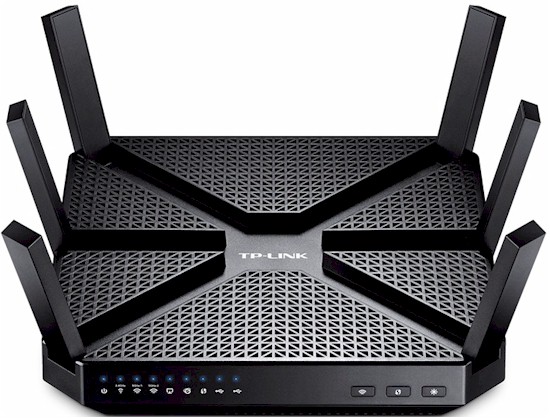
| At a glance | |
|---|---|
| Product | TP-LINK AC3200 Tri-Band Wireless Gigabit Wi-Fi Router (Archer C3200) [Website] |
| Summary | Broadcom-based AC3200 “tri-band” class router with Gigabit Ethernet ports and USB 2.0 & 3.0 storage and printer sharing. |
| Pros | • Consistent total throughput gain with Smart Connect • IPsec VPN server • Up and downlink internet bandwidth control |
| Cons | • Relatively slow storage performance • No internet port / service blocking • VPN serger gateway-to-gateway only |
Typical Price: $90 Buy From Amazon
Introduction
Updated 2/25/16 – Router performance retest due to measurement process error
The appearance of NETGEAR’s AC5300 class R8500 Nighthawk X8 may have made AC3200 class routers obsolete in the eyes of router early adopters. But for smarter folks who like someone else to debug new tech toys, AC3200 is far enough out on the new Wi-Fi technology limb. So for those wondering which AC3200 class router to buy, there’s now TP-LINK’s Archer C3200 AC3200 Wireless Tri-Band Gigabit Router to consider.
Like other AC3200 routers, the Archer C3200 uses Broadcom’s XStream "tri-band" architecture, described in MU-MIMO vs. XStream: The Coming Battle For Wi-Fi Airtime. The short story is AC3200’s key feature is its potential to squeeze higher total throughput out of multiple 5 GHz devices. XStream doesn’t bring range improvement to the party and maximum link rates are the same as AC1900 class, i.e. 600 Mbps in 2.4 GHz and 1300 Mbps in 5 GHz.
The TP-LINK’s design philosophy for the C3200 is similar to NETGEAR’s for its R8000 Nighthawk X6. Both have permanently-attached external antennas that fold up from the router top into fixed positions. Three of the antennas are dual-band, handling the 2.4 GHz and 5 GHz "1" radio; three are 5 GHz only, dedicated to the (allegedly) higher-performance 5 GHz-2 radio.
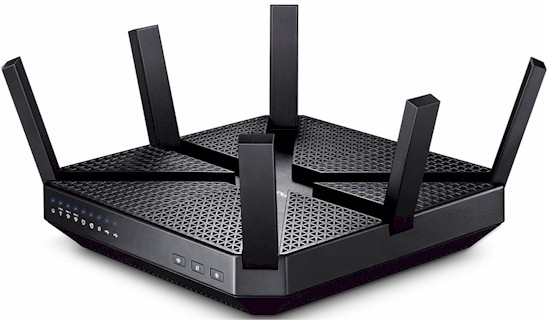
Archer C3200
All surfaces except for the rear panel have plenty of ventilation holes. There are two mounting screw slots on the bottom that can point the connectors up or down when wall-mounting the router.
The callouts for the front panel are shown below. Note these is only a single indicator for all four switched Gigabit Ethernet LAN ports and it doesn’t blink to show activity. In fact, none of the indicators blink to show activity. Three handy buttons for Wi-Fi on / off, LED on / off and WPS are right there on the front panel so you don’t have to hunt for them.
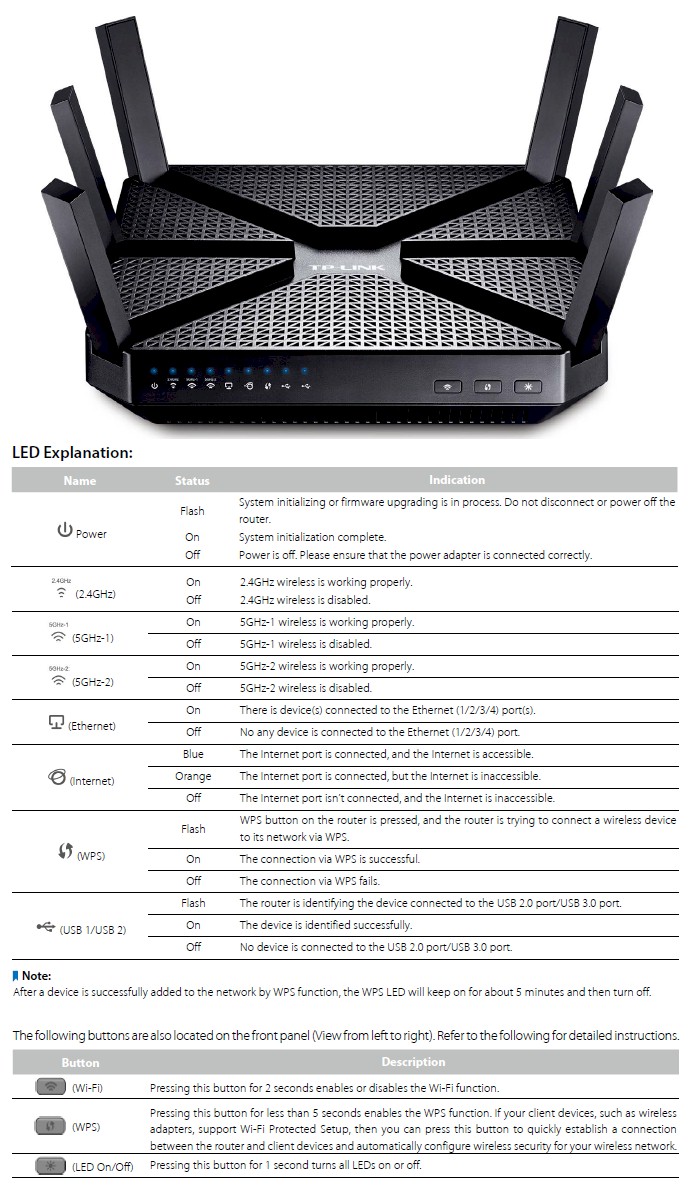
Archer C3200 front panel callouts
All Ethernet ports are Gigabit and you get one each USB 2.0 and 3.0 ports.
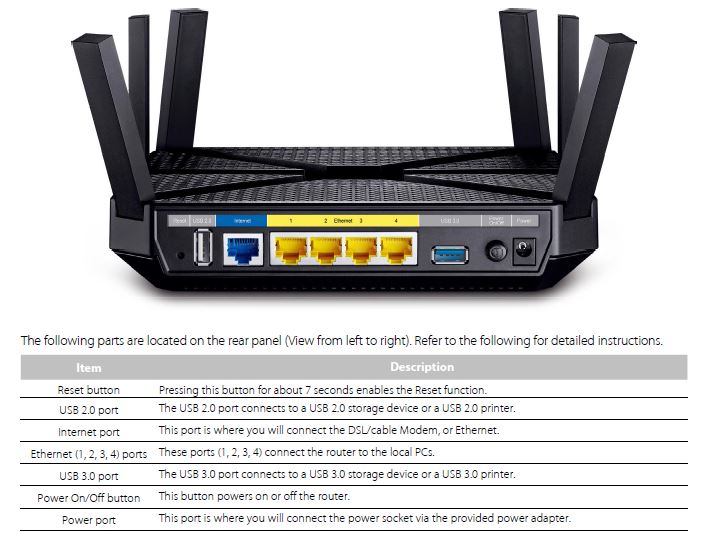
Archer C3200 rear panel callouts
Inside
The Archer C3200 has essentially the same Broadcom XStream design as all other AC3200 class routers. The view below is the top of the board after a two heatsinks and inner RF can tops are removed.
Like other AC3200 designs, there is a PLX PEX8603 PCIe switch to provide the extra PCIe port needed for the third radio. It sits to the left of the Broadcom BCM4709A SoC near photo center. Note the shield surrounding the USB 3.0 port at photo bottom right.
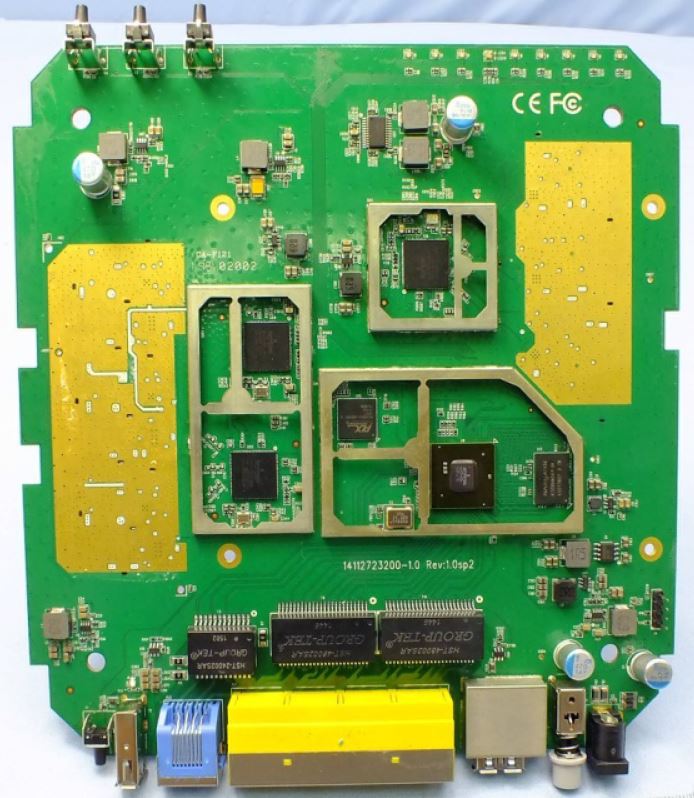
Archer C3200 board top view
The board bottom view shows the amplifiers and filters. The 2.4 GHz and 5 GHz -1 radios combine to feed the three right-side dual-band antennas (facing front of router), while the left-side 5 GHz-2 radio has its own set of left side antennas.
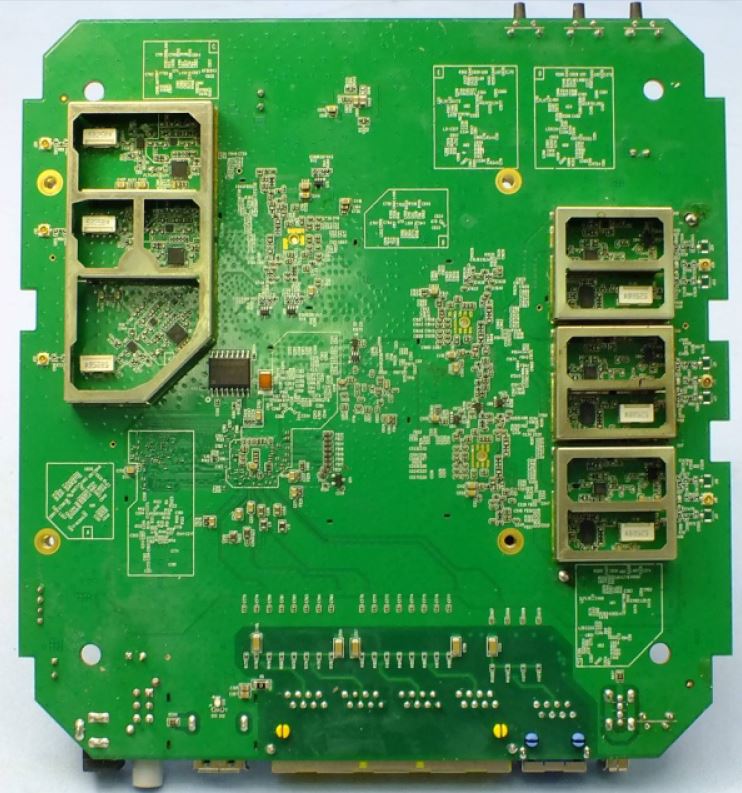
Archer C3200 inside view
All key components are summarized in Table 1. Note the separate transmit power amps and receive LNAs in the C3200’s 5 GHz-2 radio.
| TP-LINK Archer C3200 | D-Link DIR-890L/R | NETGEAR R8000 | ASUS RT-AC3200 | |
|---|---|---|---|---|
| CPU | Broadcom BCM4709A | Broadcom BCM4709A | Broadcom BCM4709A | Broadcom BCM4709A |
| Switch | in BCM4709A | in BCM4709A | in BCM4709A | in BCM4709A |
| RAM | 256 MB | 512 MB | 256 MB | 256 MB |
| Flash | 128 MB | 128 MB | 128 MB | 128 MB ? |
| 2.4 GHz Radio | – Broadcom BCM43602 – Skyworks SE2623L 2.4 GHz power amp (x3) |
– Broadcom BCM43602 – 2.4 GHz power amp (x3) |
– Broadcom BCM43602 – Skyworks SKY85309-11 2 GHz Front end (x3) |
– Broadcom BCM43602 – Richwave RTC6649E 2.4 GHz power amp (x3) |
| 5 GHz radio 1 | – Broadcom BCM43602 – Skyworks SKY85710-11 5 GHz WLAN Front end (x3) |
– Broadcom BCM43602 – Skyworks 5003L1 5 GHz Power Amps (x3) |
– Broadcom BCM43602 – Skyworks SKY85712-11 5 GHz Front end (x3) |
– Broadcom BCM43602 – Skyworks 5003L1 5 GHz Power Amps (x3) |
| 5 GHz radio 2 | – Broadcom BCM43602 – Skyworks SE5003L 5 GHz power amp (x3) – Skyworks SKY65404-31 5 GHz LNA (x3) – Skyworks SKY13408-465LF 6 GHz SP3T switch (x3) |
– Broadcom BCM43602 – Skyworks 5003L1 5 GHz Power Amps (x3) |
– Broadcom BCM43602 – Skyworks SKY85710-11 5 GHz Front end (x3) |
– Broadcom BCM43602 – Skyworks 5003L1 5 GHz Power Amps (x3) |
| PCIe | PLX Technology PEX8603 3-lane, 3-port PCIe switch | PLX Technology PEX8603 3-lane, 3-port PCIe switch | PLX Technology PEX8603 3-lane, 3-port PCIe switch | PLX Technology PEX8603 3-lane, 3-port PCIe switch |
Table 1: Component summary
The gallery below has more pictures showing various states of disassembly. All photos come from the FCC filing internal photos document.
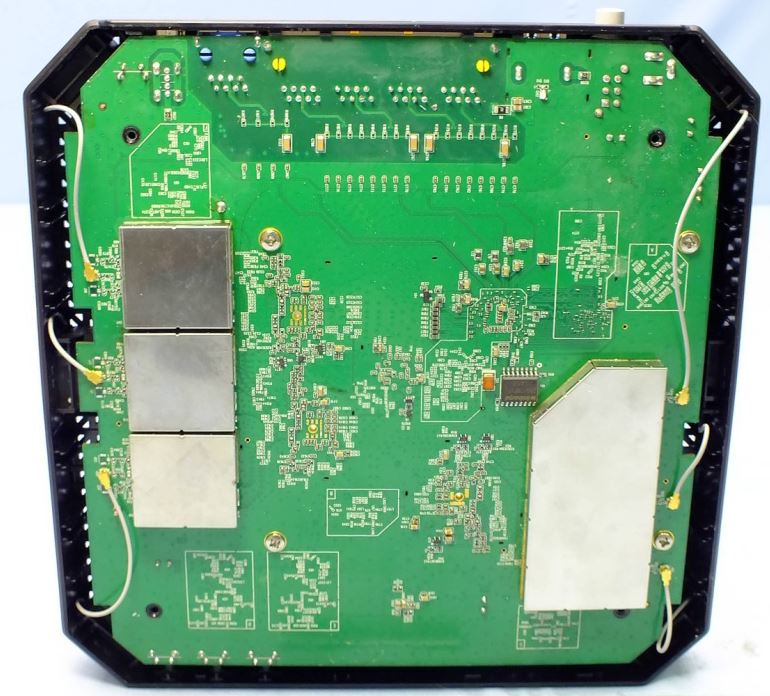
View with bottom cover removed, looking at bottom of board
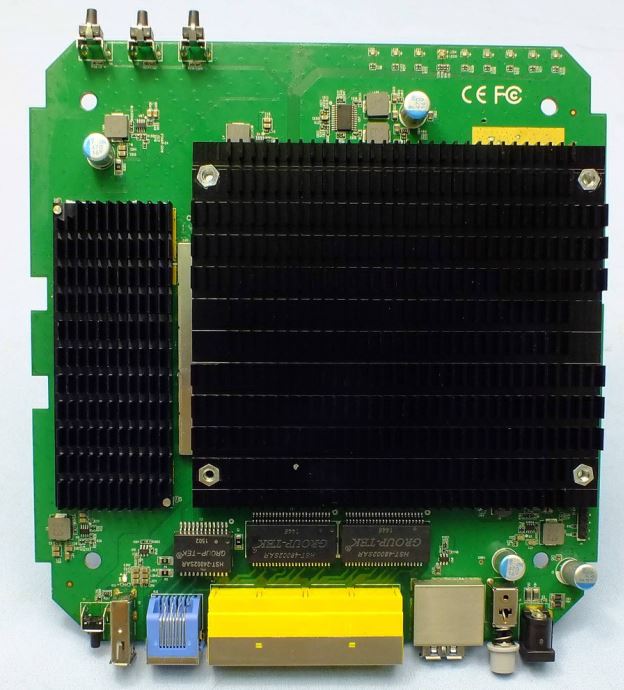
Top of board with heatsinks in place.
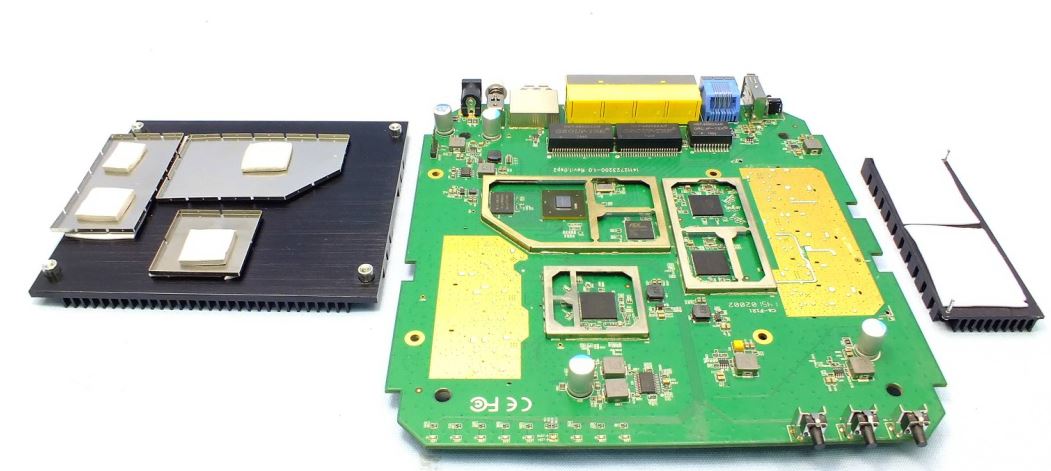
View showing heatsinks and RF can tops with thermal pads

Top of board with heatsinks and RF can tops removed.

Bottom view with RF can tops removed. These are all the transmit and receive amplifiers and associated frequency filters (larger white components).
Features
The C3200’s GUI has the same style as the Archer C8 (and C9), but features have been tweaked and reorganized a bit.
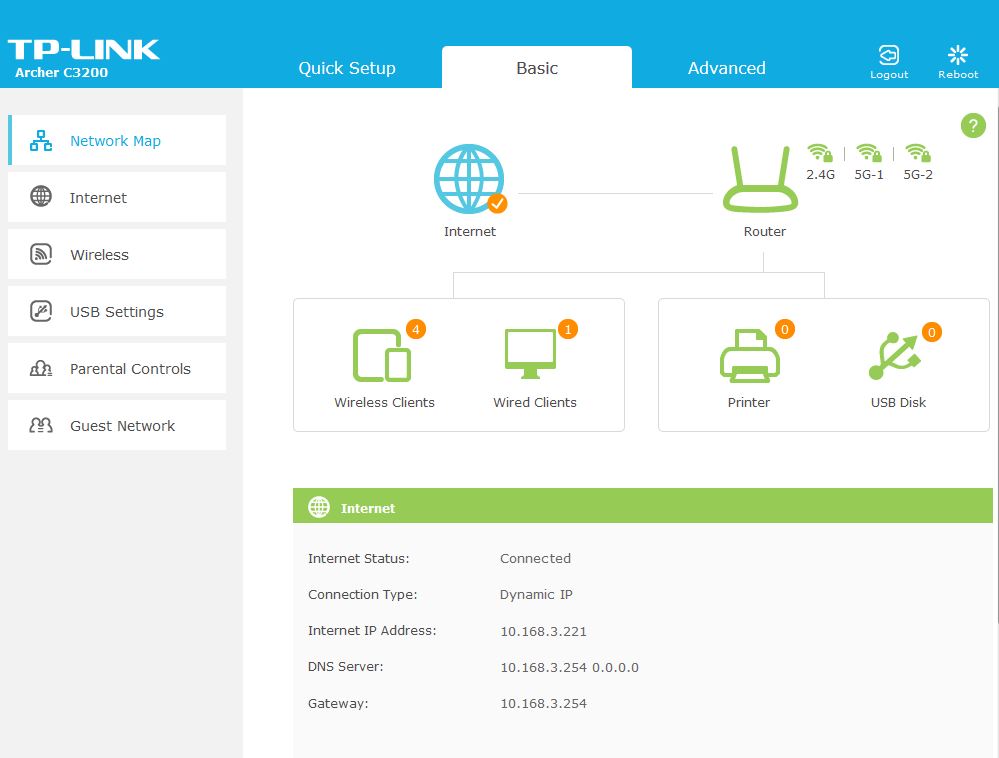
Basic mode status
Here’s a fresh summary. We’ll cover wireless features later.
Routing / Firewall
- Static IP, Dynamic IP, PPPoE, PPTP, L2TP WAN connections
- MTU Adjust on PPTP and L2TP only
- WAN MAC address clone on all connection types
- LAN IGMP snooping
- IPTV support with multiple modes, IGMP V2 / V3 select and internet / IPTV select for each LAN port
- DHCP Server with lease time setting, default domain, gatway and primary/secondary DNS
- DHCP Client list
- DHCP reservation (no pick list)
- DHCP Condition Pool
- IP / MAC binding
- Virtual Server entry for single or multiple ports with separate local and remote ports and TCP, UDP or all protocols forwarded. Enable/disable for each entry. 9 preconfigured common service ports
- Port triggering – can set individual or range of incoming ports. 9 preconfigured common applications
- DMZ Host
- UPnP enable/disable with list of current UPnP applications, settings, protocols, internal port and status
- DDNS support for Dyndns (www.dyndns.org) and No-IP (www.no-ip.com)
- IPv6 support:
- WAN types: Dynamic; Static; PPPoE; 6to4 tunnel
- LAN address assignment: SLAAC; DHCPv6 server
- MTU adjust
- SPI firewall enable/disable
- DoS controls: ICMP-Flood; UDP-Flood; TCP-Flood, Block LAN ping, Block WAN ping
- DoS controls: Low / Medium / High Flood block modes
- Blocked DoS Host list
- VPN Passthrough enable/disable for PPTP, L2TP and IPSec
- Application Layer Gateway enable/disable for FTP, TFTP, H323, SIP and RTSP
- Enable ICMP Flood filtering (with settable threshold)
- Enable UDP Flood filtering (with settable threshold)
- Enable TCP-SYN Flood attack filtering (with settable threshold)
- Ignore Ping Packet from WAN port
- Forbid Ping Packet from LAN port
- Static routes
Bandwidth Control
- Enable/disable bandwidth control with user settable upload / download speeds.
- Bandwidth rules list based on IP address (or IP range), port range and protocol
Access / Parental Control
- Schedulable internet access time by MAC address (no service / port control)
- Keyword blacklist / whitelist
USB features
- SMB storage sharing with account-based folder authentication
- FTP server (no secure FTP)
- Media server
- Print server
Admin / System
- Local management port adjust (80 default) and MAC address control
- Remote management port adjust (80 default) and single remote IP / MAC address setting
- Time zone, NTP server, daylight savings settings
- Ping and traceroute tools
- Online help (internet access not required)
- Firmware upgrade from downloaded file (no auto check)
- Backup and restore settings
- Reset to defaults
- Router reboot
- Password change
- Log with Type and Level setting and scheduled auto email (no alerts)
- LAN traffic statistics
- SNMP agent enable with Read / Set Community, System Name, Description, Location & Contact, Trap Manager IP
- LED on / off schedule
Missing Features
- HTTPS management option for either local or remote access
- Bandwidth usage monitor
- Port-based access control
- NAT Boost control
It’s disappointing to still see no HTTPS administration option, which would help secure remote access. The larger omission is the complete inability to block specific internet services. Parental controls provide only all-or-nothing internet access control.
It’s nice to see TP-LINK add a VPN server, but it’s IPsec based, not OpenVPN as found on many competing products, and for gateway-to-gateway use only; there are no VPN user accounts.
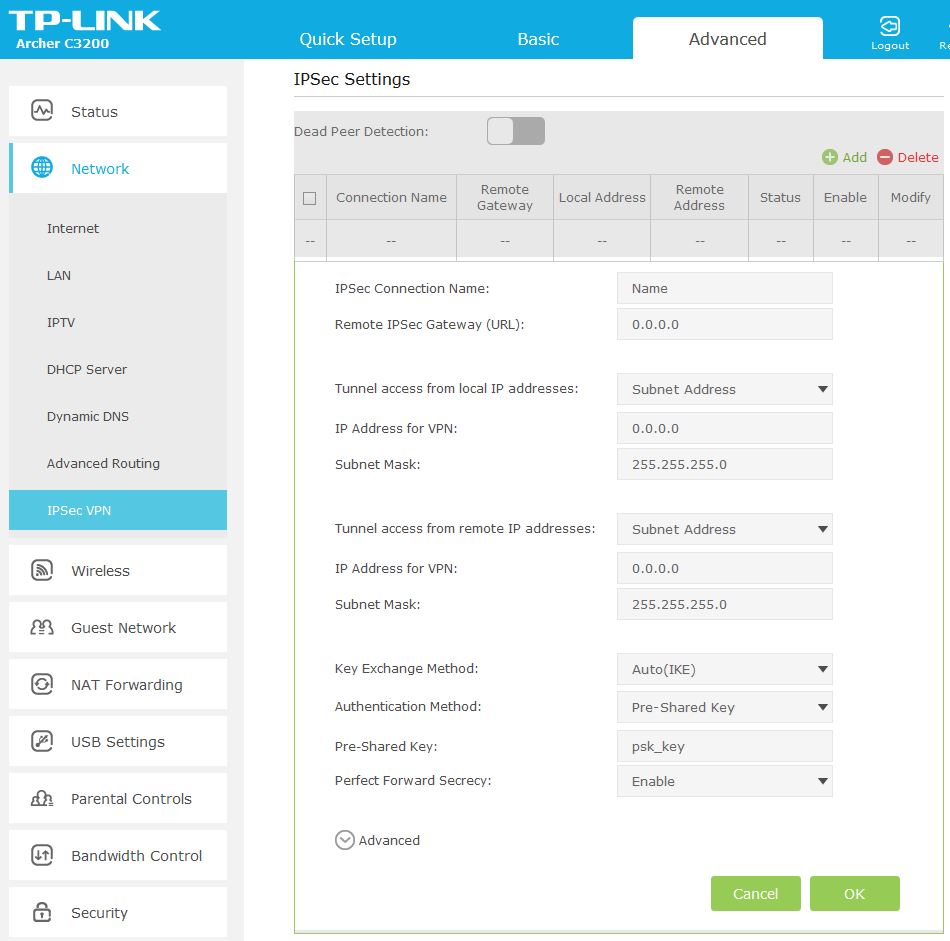
IPsec VPN server
I’ve put many of the screens with commentary into the gallery. But there’s also an online emulator if you’d like to drive the C3200 yourself.

View with bottom cover removed, looking at bottom of board

Top of board with heatsinks in place.

View showing heatsinks and RF can tops with thermal pads

Top of board with heatsinks and RF can tops removed.

Bottom view with RF can tops removed. These are all the transmit and receive amplifiers and associated frequency filters (larger white components).
Features – Wireless
Unlike other AC3200 routers, the C3200 wants to come up with all three radios operating. The screenshot below shows the default screen in the Quick Set wizard that’s launched automatically upon first accessing the router. In fact, this same screen is shown as the Basic > Wireless screen. So, clearly, TP-LINK believes Smart Connect is for Advanced users.
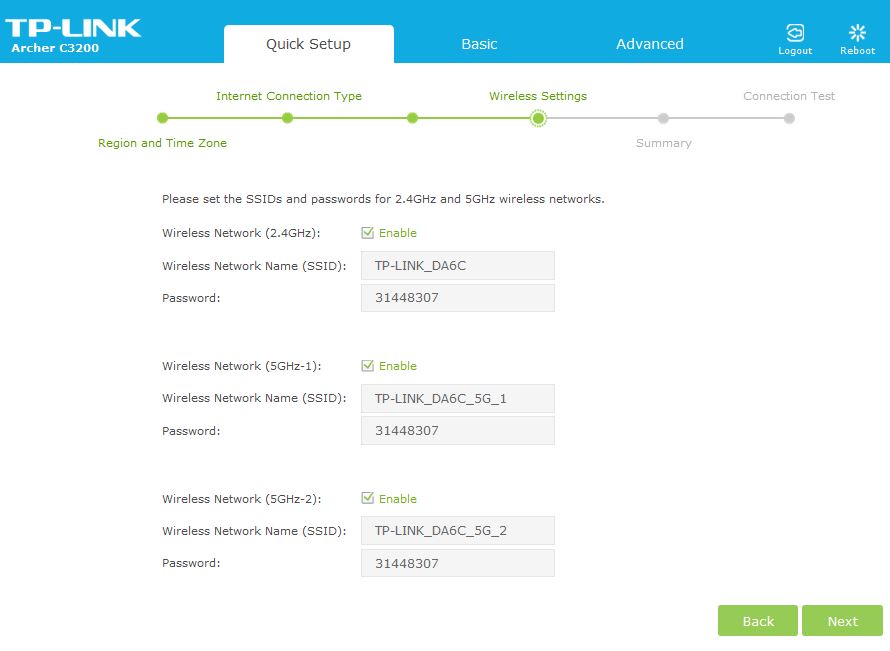
Quick Setup – Wireless
The Advanced screen below shows the 2.4 GHz radio defaults. The only change in the 5 GHz-1 and -2 screens is the mode changes to 802.11a/n/ac mixed. Note "Personal" and "Enterprise" (RADIUS) wireless security are both supported.
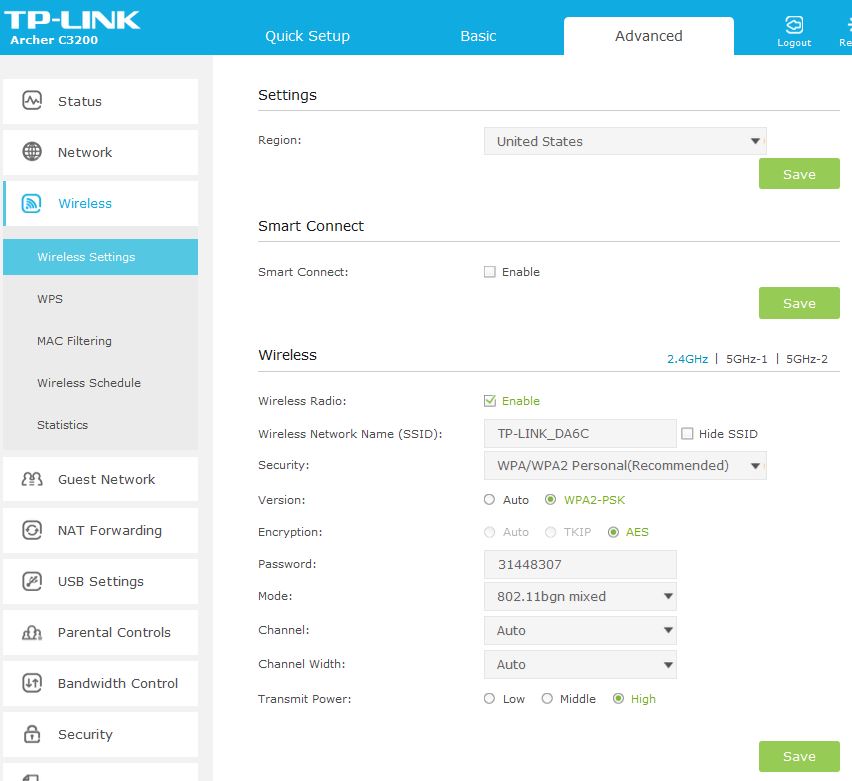
Advanced Wireless – 2.4 GHz defaults
Checking the Smart Connect Enable box sets a single SSID to whatever is shown on the screen when you check the box, i.e. the SSID for the 2.4 GHz, 5 GHz-1 or 5 GHz-2 radio. Note that Mode, Channel and Channel Width controls disappear.
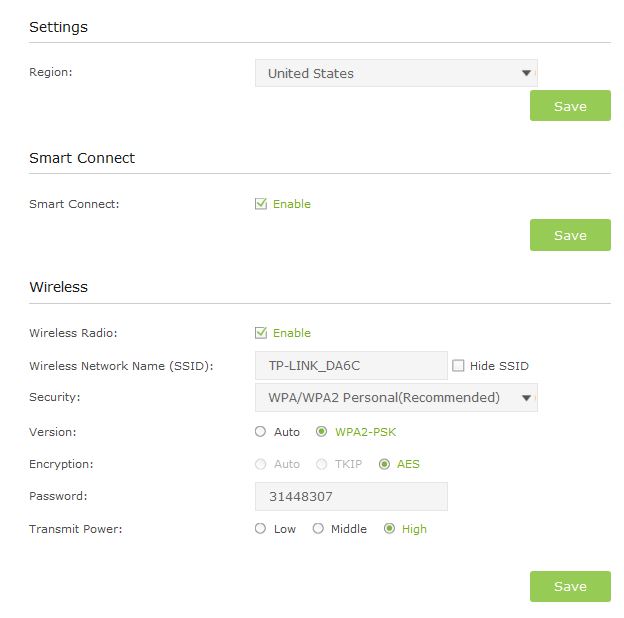
Advanced Wireless – Smart Connect Enabled
You have do some digging to locate the Advanced Wireless settings in Advanced > System Tools > System Parameters. What you see below is it; no beamforming or airtime fairness controls are to be found.
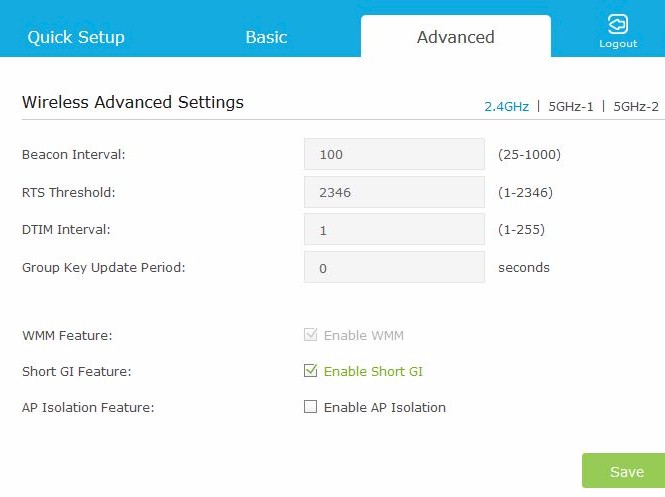
Wireless Advanced settings
Like all other AC3200 routers except ASUS’ RT-AC3200, the Archer C3200 lacks wireless bridging features; no WDS and no "universal" client bridging. There is no AP mode either.
As with other AC3200 routers, each 5 GHz radio is limited to a subset of channels. 5GHz-1 supports only channels 36, 40, 44 and 48 and 5GHz-2 supports only channels 149, 153, 157 and 161. This is due to the filtering and other design tweaks required to keep the two radios from overloading each other.
Storage Performance
The summary below shows all AC3200 routers we’ve tested with our standard procedure with USB 3.0 connection and NTFS format—the combination that should produce the highest throughput. You can get all the other benchmarks in the Router Charts.
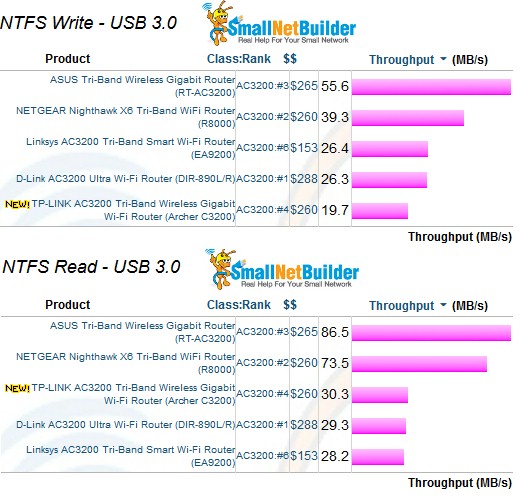
Storage Performance Comparison – USB 3.0
The Archer C3200 looks like it is limited to sub 30 MB/s USB 2.0 performance levels, even when using the USB 3.0 port. The D-Link DIR-890L/R and Linksys EA9200 have similar limitations.
Routing Performance
Updated 2/25/16 – Router performance retest due to measurement process error
Routing throughput was measured using our standard router test process with the router loaded with 0.9.1.0,1 v004b.0 Build 150831 Rel 48329n firmware. Table 2 summarizes the results and includes two other AC3200 class routers for comparison.
The maximum simultaneous connections did not hit our test process limit. For ranking purposes, we consider anything over 30,000 connections as equal, so the C3200 will rank lower than the D-Link and NETGEAR on that benchmark.
| Test Description | TP-LINK Archer C3200 | D-Link DIR-890L/R | NETGEAR R8000 |
|---|---|---|---|
| WAN – LAN (Mbps) | 821 | 784 | 806 |
| LAN – WAN (Mbps) | 797 | 797 | 782 |
| Total Simultaneous (Mbps) | 1434 | 1428 | 1392 |
| Maximum Simultaneous Connections | 26,611 | 33,828 | 34, 083 |
| Firmware Version | 0.9.1.0,1 v004b.0 Build 150831 Rel 48329n | 1.03 | 1.0.0.90 |
Table 2: Routing throughput
The IxChariot unidirectional composite plot for shows typical cyclical variation between mid-to-high 700 Mbps range and peak speeds near 950 Mbps for both directions. Average WAN – LAN throughput is about 25 Mbps higher than LAN – WAN.
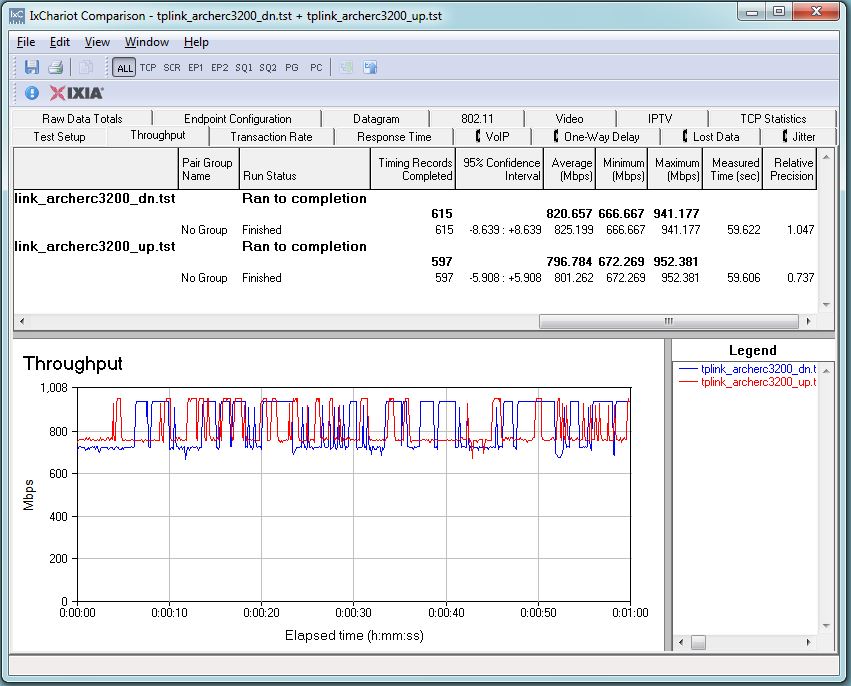
Archer C3200 routing throughput unidirectional summary
The simultaneous up/downlink benchmark plot shows the some battling at the beginning, due to IxChariot’s Nagle’s algorithm implementation. Once that settles down, the throughput is fairly stable with higher uplink vs. downlink throughput, again another artifact of our test method.
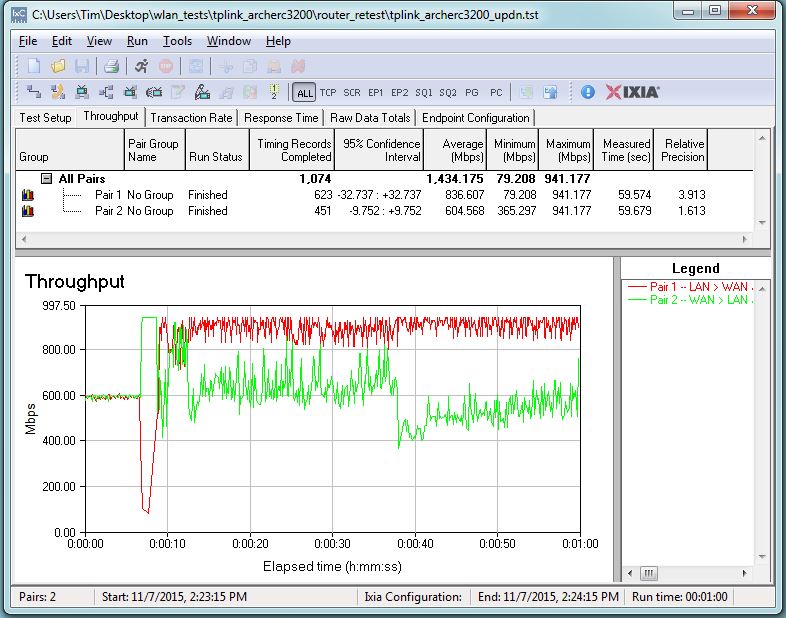
Archer C3200 routing throughput bidirectional summary
Wireless Performance
The Archer C3200 is not Wi-Fi Certified. It was tested using the Revision 8 Wireless test process with 0.9.1.0,1 v004b.0 Build 150831 Rel 48329n firmware loaded. The router comes with WPS enabled.
A Windows 8.1 notebook connected to the router’s SSID prompted for WPS PIN with a pushbutton alternative. A pushbutton session quickly resulted in a WPA2/AES connection to either radio (identified by the link rate reported in the Windows connection properties). WPS can be disabled via a hidden-away control on Advanced > System Tools > System Parameters.
For performance testing, the router was first reset to factory defaults, Smart Connect disabled and unique SSIDs assigned to each radio. The 2.4 GHz radio was set to Channel 6 and 20 MHz only bandwidth mode. The "Primary" 5 GHz (low-band) radio was disabled and the "5 GHz-2" (high band) 5 GHz radio was set to Auto channel width to enable 802.11ac link rates. Throughput tests were run on the "5 GHz-2" radio since it is the only one that supports our standard Channel 153 test channel. The NETGEAR R7000 bridge mode standard test client was connected using WPA2/AES encryption.
Our standard practice is to center the router under test’s antennas on the turntable, both front-to-back and side-to-side in the chamber. This method is intended to keep maximum distance between the router under test and chamber antennas as the router rotates during test. Since the C3200’s antennas are symmetrically arranged, the router body was centered on the chamber turntable.
The Benchmark Summary below shows a summary of the tested benchmarks. Note the wireless benchmarks represent the average of all wireless throughput measurements made over the tested attenuation range.

Archer C3200 Benchmark Summary
We’ll put these results in perspective when we look at throughput vs. attenuation profiles next. Note the near-equal USB 2.0 and 3.0 storage performance results noted earlier.
The Archer C3200 is the sixth AC3200 class router reviewed to date. I chose the top-ranked D-Link DIR-890L/R and bottom-ranked Linksys EA9200 to compare throughput vs. attenuation performance. This provides a better view of best-to-worst performance and where the C3200 fits between the two.
2.4 GHz downlink performance is very similar at the start, with a slight edge for the C3200. It then falls off more quickly than the others, but stays connected out to the full 63 dB test limit.
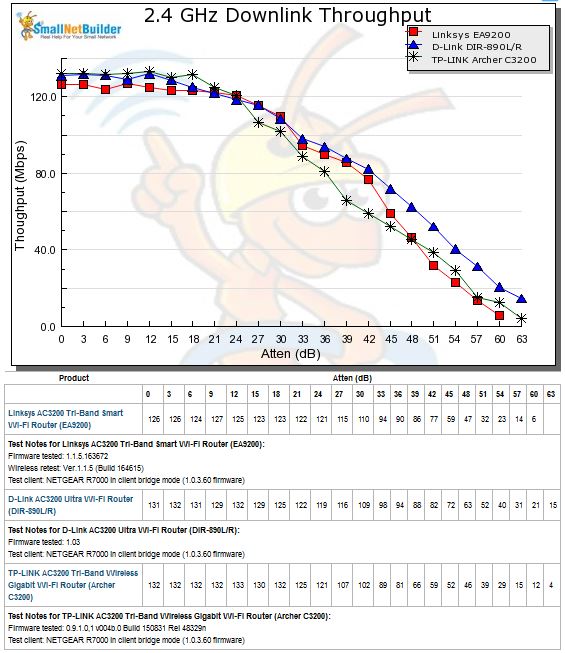
2.4 GHz Downlink Throughput vs. Attenuation
2.4 GHz uplink plot shows the Archer C3200 throughput again starting its decline earlier than the other two routers. But again, it stays connected for the complete test. The upshot of all this is that it’s unlikely you would see a real difference among the routers in actual use.
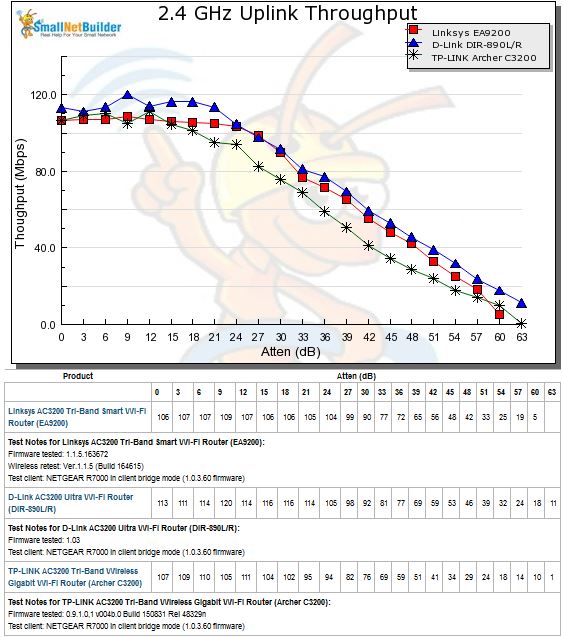
2.4 GHz Uplink Throughput vs. Attenuation
Performance spreads out in the 5 GHz downlink profile. The clear loser here is the Linksys with throughput below the D-Link and TP-LINK over the entire tested range. The C3200 runs neck-and-neck with the DIR-890L/R over the tested range and disconnects last, after the 39 dB test.
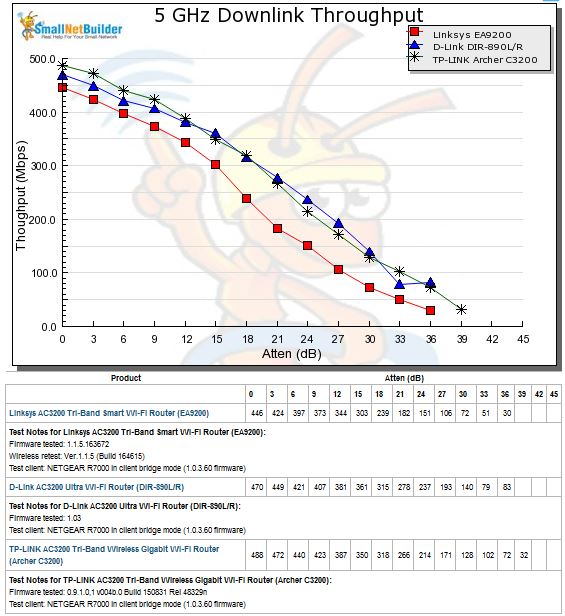
5 GHz Downlink Throughput vs. Attenuation
On 5 GHz uplink, the Linksys EA9200 once again turns in the lowest performance of the three. The C3200 tracks solidly between it and the D-Link and again disconnects last.
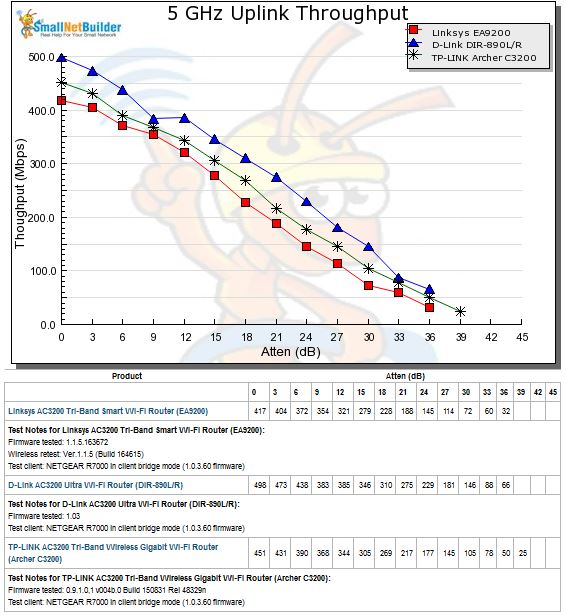
5 GHz Uplink Throughput vs. Attenuation
The Router Ranker placed the Archer C3200 in the #4 slot, above the TRENDnet TEW-828DRU and Linksys EA9200. The D-Link DIR-890L/R remains unchallenged in the #1 slot.
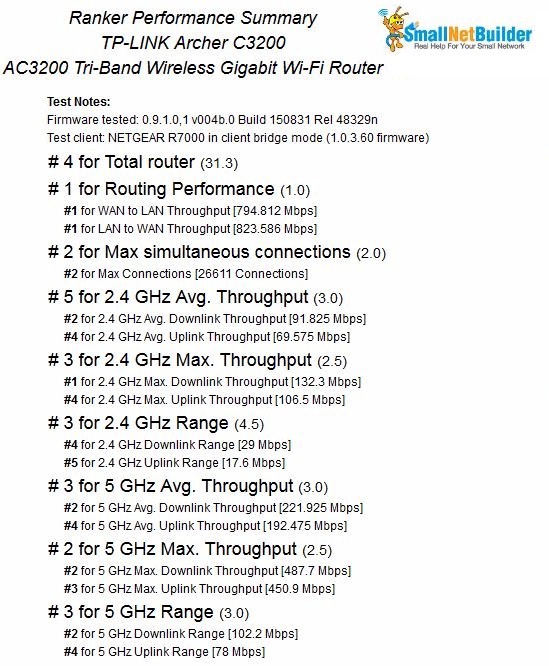
Archer C3200 Ranker Performance Summary
Smart Connect
For Smart Connect testing, the Archer C3200 was located in the wireless testbed upper test chamber with the door open. The bridge mode R7000 was in the lower chamber with the door closed. This allowed using the testbed programmable attenuators to control the signal and therefore the link rate of the R7000. I set 20 dB of attenuation so that the R7000 throughput wouldn’t dominate the other AC devices. All other devices were located within 6 feet of the Archer C3200, outside the test chamber and all received a nice, strong signal.
Like all other AC3200 routers except ASUS’ RT-AC3200, the Archer C3200 treats Smart Connect like a black box. The only thing you can do is disable and enable it.
It took some work to track how clients connected to the C3200’s three radios because TP-LINK splits the needed information between two screens. NETGEAR still provides the best device connection summary as shown below. Radio, MAC address, device name and IP address are shown in one compact view.
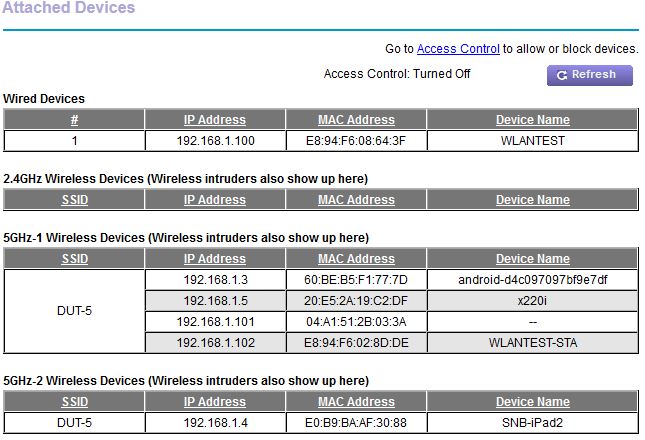
NETGEAR R8000 device connection table
For the C3200, I had to bounce between two screens shown in the composite image below, using MAC addresses to figure out what was connected where. In the end, the information was there, but it was work to extract it!
![]()
TP-LINK Archer C3200 Smart Connect client connection tracking
I first disabled Smart Connect and connected all clients to the 5GHz-2 radio set to Channel 153. The IxChariot plot below shows this test yielded 80 Mbps of total throughput from the five clients. Total uplink throughput on this run was 99 Mbps.
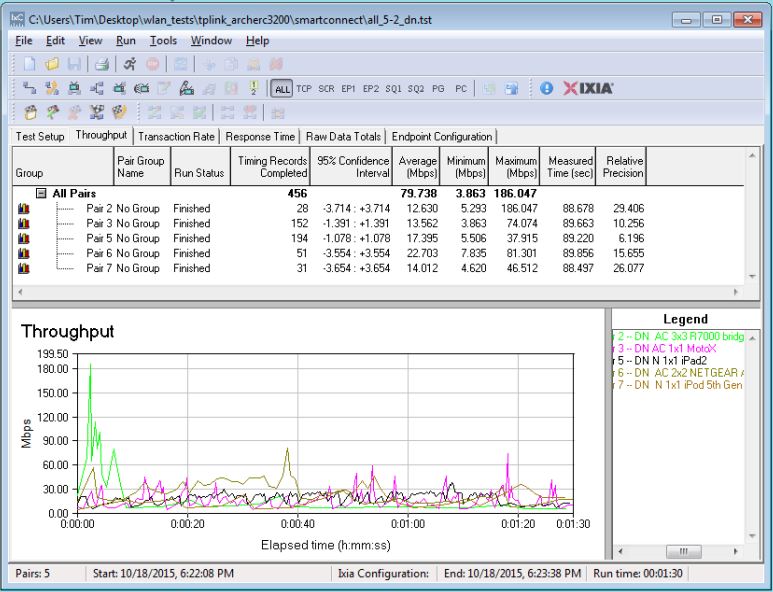
Total downlink throughput – All clients on 5GHz-2 radio
Smart Connect was then enabled with a different SSID set so that clients wouldn’t just reconnect with their previous SSID. All clients were then associated with the new single SSID. Note the R7000 bridge used as a 3×3 AC client must be assigned to a band, so I chose 5 GHz.
Table 3 shows the devices, type, device descriptions shown in the Client Name column in the table above and Legend panel in the following IxChariot plots and the C3200 radio they initially connected to.
| Device | Type | IxChariot Legend | Client Name | Connected To |
|---|---|---|---|---|
| Moto X smartphone | 1×1 AC | MotoX | android-d4c09709-7bf9e7df | 2.4 GHz |
| NETGEAR R7000 in client bridge mode | 3×3 AC | R7000 bridge | Not shown | 5 GHz-1 |
| Laptop with NETGEAR A6200 USB adapter | 2×2 AC | NETGEAR A6200 | x220i | 5 GHz-1 |
| iPad 2nd gen | 1×1 N | iPad2 | SNB-iPad2 | 5 GHz-2 |
| iPod Touch 5th gen | 1×1 N | iPod 5th Gen | Tim-Touch-G5 | 5 GHz-2 |
Table 3: Smart Connect Test devices
The C3200 was then power-cycled to let the clients reconnect on their own. This test yielded 282 Mbps total throughput running downlink and 235 Mbps total throughput running uplink, gains of 252% and 137%, respectively. Comparing the two plots shows all clients gaining throughput except for the iPad.
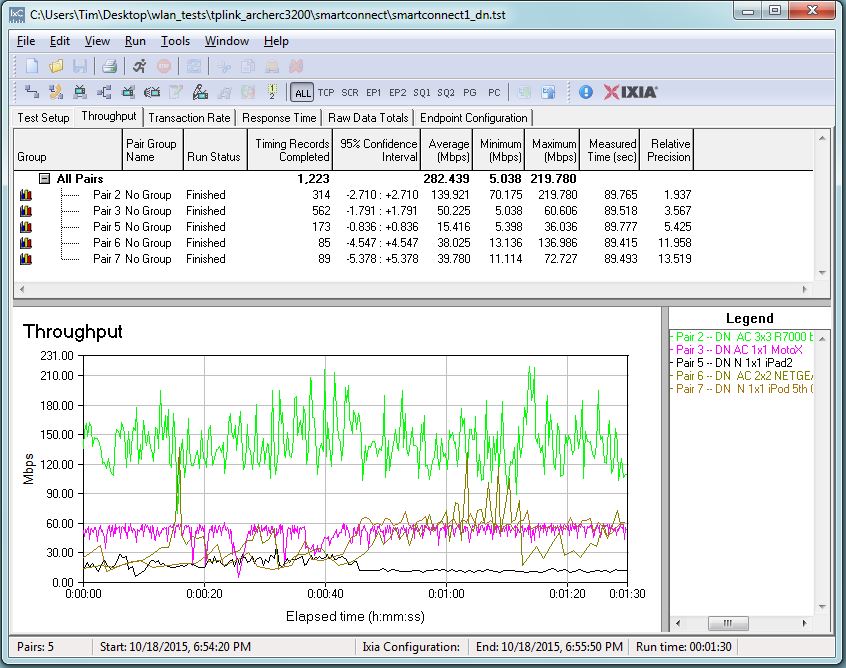
Total uplink throughput – First Smart Connect run
For the second test, the router was power cycled and the clients were allowed to connect. After checking connections, I found everything connected to the same radios as in the first run. Test 2 resulted in 268 Mbps total downlink throughput and 232 Mbps total uplink.
For the last test, I moved the iPad and iPod Touch to a hallway table around 20 feet from their previous spot and once again power-cycled the router. The move significantly reduced their signal level to see if Smart Connect would change things up a bit. Nope. Everything once again connected exactly the same as before to yield total throughputs of 273 Mbps downlink, 208 Mbps uplink.
All the results are compiled in Table 4 along with the % change in throughput in each direction compared to the initial run with all clients connected to the 5GHz-2 radio. In all three test runs there was a total throughput gain from Smart Connect in each direction.
| Total Downlink (Mbps) | Total Uplink (Mbps) | % change downlink | % change uplink | |
|---|---|---|---|---|
| Reference | 80 | 99 | N/A | N/A |
| Smart Connect Trial 1 | 282 | 235 | 252 | 137 |
| Smart Connect Trial 2 | 268 | 232 | 235 | 134 |
| Smart Connect Trial 3 | 273 | 208 | 241 | 110 |
Table 4: Smart Connect Test summary
All the IxChariot plots are in the gallery below, so that you can see how individual devices behaved.

View with bottom cover removed, looking at bottom of board

Top of board with heatsinks in place.

View showing heatsinks and RF can tops with thermal pads

Top of board with heatsinks and RF can tops removed.

Bottom view with RF can tops removed. These are all the transmit and receive amplifiers and associated frequency filters (larger white components).
So how does the Archer C3200’s Smart Connect compare to other AC3200 routers? Table 5 compares the best results from all four products and shows the Archer C3200 with the highest total throughput gain from Smart Connect.
| Product | Without (Mbps) | With (Mbps) | % gain |
|---|---|---|---|
| TP-LINK Archer C3200 | 80 | 282 | 252 |
| NETGEAR R8000 | 83 | 247 | 198 |
| Linksys EA9200 | 86 | 237 | 186 |
| ASUS RT-AC3200 | 138 | 205 | 49 |
| D-Link DIR-890L/R | 221 | 322 | 46 |
Table 5: Smart Connect Total Throughput gain comparison – downlink
Closing Thoughts
Judging from SNBForums discussions, there’s not a lot of love for Broadcom’s Smart Connect technology. Many users report constant device disconnects and some devices that won’t connect at all with it enabled. So some AC3200 router buyers end up turning Smart Connect off and manually assigning devices to get some benefit from their high-priced purchase.
Some of this isn’t Broadcom’s fault. Some devices are designed to hold on to their connection come hell or high water and refuse to be moved, even if the new connection has the same SSID, as Smart Connect presents.
So in that light, the Archer C3200’s achievement of consistent gains in total throughput in our testing is an impressive achievement. Whether it’s luck or good design, I don’t know. But the gains were consistent and the devices stayed connected.
That said, most folks looking to step up to an AC router will find better bang for the buck from an AC1900 class router, or AC1200 class if you have only a few wireless devices and/or a smaller space to cover. AC3200 class is primarily for folks with a lot dual-band capable devices in simultaneous use. Think three or four people watching streaming video, with some also downloading a large file or Torrent, while other household members just trying to catch up on Facebook or email.
If this sounds like your house, AC3200 might be for you. But if you want to keep the usual futzing around that comes along with Smart Connect to a minimum, the TP-LINK Archer C3200 could be your best bet.
 Buy AC3200 Tri-Band Wireless Gigabit Wi-Fi Router from Amazon
Buy AC3200 Tri-Band Wireless Gigabit Wi-Fi Router from Amazon
